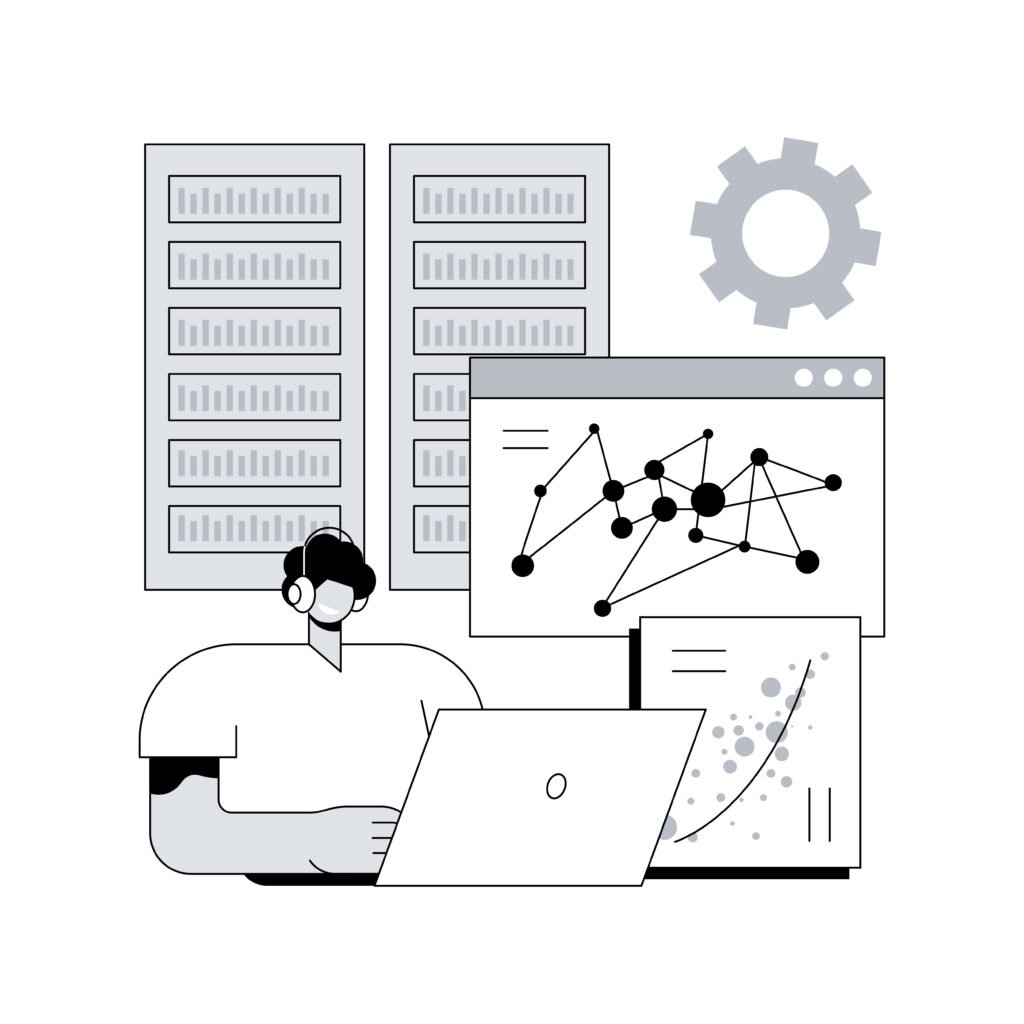- Data Engineering Framework: Goals and Application Area
- Data Science and Data Engineering: How Do They Differ?
- Navigating Big Data's Labyrinth: Taming the Giants of Information
- Building Reliable Data Infrastructure
- Overview of ETL Processes
- The Quest for Pristine Data: Guardianship through Quality Assurance
- Concluding Foundations: Echoing Data Engineering's Everlasting Resonance
Data Engineering Demystified: Building the Foundation for Data-Driven Systems
28 Sep 2023
Ilya Lashch

Imagine you have a treasure chest full of precious gems, but they’re all scattered around in different shapes and sizes. To unlock the true value of those gems, you need someone who can carefully clean, sort, and arrange them, making them shine brilliantly. Well, that’s what data engineering does for data!
It’s like the unsung hero behind the scenes who ensures that data is well-organized, easily accessible, and ready for data scientists and analysts to work their magic. Without robust data engineering processes, organizations would struggle to derive meaningful insights from their data, hindering their ability to make informed choices, provide meaningful analytics, and foster data-driven culture in their companies. Data engineering bridges the gap between raw data and actionable intelligence, making it a critical component of any successful data-driven strategy. In this article, you will discover the role of data engineering in establishing the groundwork for effective data system orchestration and what are its modern best practices.
Data Engineering Framework: Goals and Application Area
Data engineering is the process of collecting, cleaning, modifying, and organizing data into a format that is easily accessible and useful for analyzing and transforming data flow. It plays a crucial role in the data pipeline, ensuring that data is reliable and available for various data-driven tasks.
By preparing data for analytical or operational purposes, the data engineering lifecycle pursues the goals below.
| Goal | Result |
| Seamless data integration | – Improved data accessibility and consistency – Centralized source of truth for reporting and analysis for data scientists and analysts – Reduced data silos and enhanced cross-functional collaboration |
| Data quality assurance | – Enhanced data reliability – Decreased likelihood of errors in analyses and decision-making – Improved trust in the data-driven insights generated from the data |
| Scalable data processing | – Increased scalability and performance of data processing systems – Unlocked possibility of processing and analyzing larger datasets without performance bottlenecks – Resilient and sustainable data systems |
For us to better understand the principles of data engineering, let’s examine three examples of data engineering applications in different industries.
Martech
In the Martech industry, data engineering gathers and processes vast user data, including transaction records, website interactions, and demographics. This data is then organized and prepared for analysis to understand user behavior, improve recommendation systems and UX personalization, optimize ad campaigns, and more.
Data engineers create pipelines that enable real-time website performance monitoring and user actions, helping Martech companies make data-driven decisions to fine-tune user experience and boost conversions.
Healthcare
Data engineering is crucial for managing electronic health records (EHRs), medical imaging data, and patient information in healthcare. Data engineers design systems to securely store and process sensitive healthcare data while ensuring compliance with privacy regulations.
They create pipelines for extracting insights from patient data, such as identifying disease trends, predicting patient outcomes, and improving treatment plans.
IoT and Manufacturing
Architecting data ecosystems in manufacturing is increasingly vital for implementing Industry 4.0 principles. Sensors and IoT devices on factory floors generate massive data volumes on machinery performance, production processes, and product quality.
Data engineers create dashboards and analytics tools that allow manufacturers to monitor equipment health, optimize production schedules, and prevent costly downtime. The data engineering lifecycle supports predictive maintenance, quality control, and overall efficiency in manufacturing.
Data Science and Data Engineering: How Do They Differ?
At first glance, data science and data engineering principles may appear to be the same. However, these two concepts are closely related but distinct fields.
Data science encompasses the entire lifecycle of converting raw data into actionable information, while data engineering is a more specialized data-related field. Let’s set the record straight.
Data science
Focus: Extracting insights and knowledge.
Key tasks: Statistical analysis, machine learning, data modeling.
Role: Generates actionable insights.
Tools: Python, R, machine learning libraries.
Data science primarily deals with extracting insights and knowledge from data. Data scientists use statistical analysis, machine learning, and domain expertise to uncover patterns and generate actionable insights from raw data, thus empowering decision-making. They are responsible for understanding business problems, formulating questions, and using data to answer them. Data scientists often work with data engineers to access and prepare the data required for analysis.
Data engineering
Focus: Data infrastructure and pipeline.
Key tasks: Data collection, storage, ETL (Extract, Transform, Load) processes.
Role: Establishes data pipelines and systems.
Tools: SQL, Hadoop, Spark, database management systems.
Data engineering, on the other hand, focuses on the practical application of collecting, storing, and processing data. Data engineers build and maintain the infrastructure, databases, and pipelines that allow data scientists and analysts to access and work with data efficiently. They often work on tasks like data ingestion, transformation, and integration. They create the foundation upon which data scientists build their analytical models.
Navigating Big Data’s Labyrinth: Taming the Giants of Information
When handling massive datasets, companies face several challenges, and data engineering plays a key role in addressing them. We compiled three primary challenges and how data engineering services can help mitigate them.

- Data storage and management
Challenge: Storing and managing vast amounts of data efficiently is a significant challenge. Traditional databases may not scale to handle Big Data’s volume, variety, veracity, and velocity.
Solution: Data engineering designs and implements scalable storage solutions, such as distributed file systems (e.g., Hadoop HDFS), distributed databases (e.g. clusters, shards), or NoSQL databases for non-relational data (e.g., Cassandra, MongoDB). These systems are optimized for handling large datasets and can be easily scaled as data grows.
- Data processing and analysis
Challenge: Performing analytics on massive datasets on time can be computationally intensive and time-consuming, often leading to bottlenecks.
Solution: Data engineering creates data pipelines and parallel processing frameworks (e.g., Apache Spark) to distribute data processing tasks across clusters of machines. This parallelization significantly accelerates data analysis and ensures real-time or near-real-time insights from Big Data.
- Data quality and cleansing
Challenge: Big Data often contains noisy, incomplete, or inconsistent data, leading to inaccurate analysis and decision-making.
Solution: Data engineers implement data quality checks and cleansing processes while crafting data pipelines. They develop data validation, error detection, and cleansing procedures, ensuring that only high-quality data enters the analysis pipeline. Additionally, data engineering can establish data governance practices to maintain data quality over time.
Overall, navigating big data challenges is impossible without establishing robust foundations. They provide the infrastructure and processes to handle large datasets’ sheer volume, variety, veracity, and velocity. Without data architecture synergy, organizations would struggle to store, process, and analyze big data, limiting their ability to extract valuable insights and make well-informed decisions.
Building Reliable Data Infrastructure
One of the most critical tasks in any data engineering lifecycle is to ensure that the correct data gets to the right users or systems at the right time.
An organization must have a solid data infrastructure to keep data flowing, protect data quality, minimize redundant data, and prevent important data from becoming isolated in silos to achieve this goal.
Data infrastructure creation encompasses designing, implementing, and maintaining the underlying technology stack and architecture needed to efficiently store, process, and manage data within an organization. The elements considered part of the data infrastructure may vary from company to company and even from person to person within an organization. Some options are the following:
1. Physical infrastructure
- Storage hardware
- Processing hardware
- Input/Output (I/O) networks
- Data center facilities, including power, rack space, and network connectivity
2. Information infrastructure
- Enterprise applications
- Data repositories (including databases, data warehouses, data lakes, and data lakehouses)
- System virtualization
- Cloud services, including Software-as-a-Service (SaaS) applications
3. Corporate infrastructure
- Business Intelligence (BI) systems
- Analytics tools, including big data, artificial intelligence (AI), and machine learning (ML) systems
In general, data infrastructure creation encompasses the design, implementation, and maintenance of the underlying technology stack and architecture needed to efficiently manage data within an organization.
These elements include all employees, services, policies, and processes involved in working with data across the enterprise, from the core to the edge to the cloud. Ensuring data quality depends on ETL process optimization.
Overview of ETL Processes
ETL stands for Extract, Transform, and Load. It’s like a conveyor belt in data management. Let’s take a simple example of this process.
Extract: Imagine you have a big box of different-shaped toys. This step is like taking out the toys you need from the box. In ETL, we’re getting data from the data infrastructures discussed above.
Transform: Now, you want to make all those toys look the same or fit into the same box. So, you might clean them, paint them, or reshape them. In ETL, we’re changing the data to make it neat, consistent, and ready for use.
Load: Finally, you put all the transformed toys into a new box, ensuring they fit nicely. In ETL, we’re saving the cleaned and organized data into a specific data infrastructure so people can easily find and use it to make reports or predictions.
ETL is a systematic data transformation, preparing data by taking it from different places, fixing it up, and storing it neatly so that it’s ready for data architects to use.
The introduction of the ETL processes makes sense, especially if data comes from different sources, possessing different formats and structure, which makes deriving insights from such data prone to errors or entirely impossible. In this case, creating a central repository for all data analysis is a way out.
Besides ETL approach, there is an ELT one (extract, load, transform) — these 2 types of pipelines differ in the sequence of operations with data when loading.
Data analytics solution companies help organizations harness the power of data to make informed decisions and gain a competitive edge in their industries. You may request a strategic consultation to adopt best practices for data engineering.

The Quest for Pristine Data: Guardianship through Quality Assurance
ETL processes logically continue with quality assurance in data. QA techniques are critical in ensuring data validation, cleansing, and vigilant data lineage tracking in data engineering. You can use the following scope of activities as a checklist.
1. Data validation
- Create test cases that cover various data scenarios and validate data against predefined criteria.
- Use data profiling tools to examine data characteristics and identify anomalies or inconsistencies.
- Implement validation rules and constraints to check data accuracy and adherence to defined standards.
2. Data cleansing
- Define data quality metrics and thresholds and regularly monitor data against these benchmarks.
- Develop scripts or automated processes to clean data based on predefined rules, such as removing duplicates or filling in missing values.
- Employ statistical algorithms and outlier detection techniques to identify and address data outliers.
3. Data lineage tracking
- Implement metadata management systems to catalog data sources, transformations, and destinations.
- Maintain change logs that record all data modifications, providing a historical record of data lineage.
- Map dependencies between data elements, processes, and systems to visualize data lineage and identify potential impact points.
- Establish version control mechanisms to track changes and updates to data, ensuring accurate data lineage over time.
These QA techniques help maintain data quality, trace data changes, and ensure that data engineering processes remain transparent, reliable, and aligned with organizational standards and requirements.
Concluding Foundations: Echoing Data Engineering’s Everlasting Resonance
The importance of data engineering will increase in the future. Companies are already realizing the benefits of big data and investing in data science initiatives. Data engineering will follow suit because data science relies on sustainable, standardized data.
Modern best data engineering practices include setting goals, choosing a proper data infrastructure, conducting seamless ETL processes, and ensuring continuous quality assurance. Achieving engineering excellence requires a dedication to continuous improvement and the pursuit of cutting-edge technologies.
To leverage the full potential of data, consult an experienced service provider who can design and implement tailored data engineering solutions that align with your organization’s goals and facilitate the seamless flow of high-quality data for informed decision-making.


